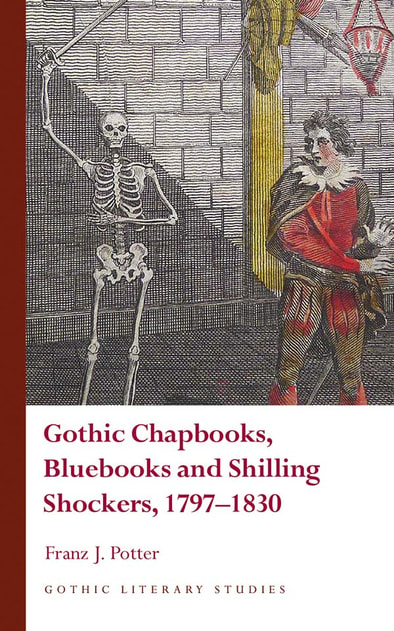
TITLE: Gothic Chapbooks, Bluebooks and Shilling Shockers, 1797-1830
AUTHOR: Franz J. Potter
PUBLISHER: University of Wales Press
ISBN: 9781786836700
PODCAST EPISODE: None
REVIEWER: Hilary Wilson
Gothic Chapbooks, Blue Books, and Shilling Shockers, 1797 - 1830 by Franz J. Potter is part of the Gothic Literary Studies series by University of Wales Press. This groundbreaking series offers readers the most up-to-date scholarship concerning both Gothic literature and film. Every volume of this series focuses upon questioning the traditional views of the genre through studying how issues such as gender, religion, nation and sexuality have informed previous studies as well as the public perception of the genre itself. The series is invaluable for anyone deeply interested in the field.
In the latest entry in the series, Franz J. Potter explores the often overlooked importance of the Gothic chapbook in detail. He contextualizes chapbooks as the powerhouses of popular culture that they were when first issued, and explores how their popularity waxed and waned throughout the years. Potter places these publications firmly within the context of the time in which they were written and through a careful analysis of their development, marketing, distribution, and eventual decline in popularity asserts their importance in the history and future of Gothic Studies. Furthermore, in the latter section of the book, Potter treats readers to well-researched biographies of the most important publishers, booksellers, and writers of these chapbooks and details how their positions within society affected their legacy within popular studies of this genre.
This is the first in-depth study of chapbooks published since the 1960s, and it corrects the errors that had been perpetuated by its predecessor as well as compiling decades worth of new knowledge. The book is carefully sourced throughout, and indeed nearly half of the pages make up the appendices and sources. The largest appendix is, perhaps unsurprisingly, an accounting of every currently known chapbook–who wrote it and where it was written, as well as where it is currently held today. This resource will prove invaluable for those who wish to study the contents of the actual pamphlets themselves.
One of the most interesting aspects of the book was the analysis of how class and sex affected the way that chapbooks were viewed both in their own time as well as by later scholars. Chapbooks were primarily marketed to the lower class, and some of the most prominent known writers and publishers were women; these two facts in conjunction have caused them to be disparaged rather than properly studied despite the fact that they have influenced Gothic literature up to the modern day.
This book is a must for anyone studying this truly fascinating field, and would be an invaluable addition to any academic library. The Appendix alone will aid in future studies of these chapbooks and their contents, and hopefully will aid the particularly intrepid folklorists who hope to scour the texts to uncover undiscovered spells or forgotten local legends.
AUTHOR: Franz J. Potter
PUBLISHER: University of Wales Press
ISBN: 9781786836700
PODCAST EPISODE: None
REVIEWER: Hilary Wilson
Gothic Chapbooks, Blue Books, and Shilling Shockers, 1797 - 1830 by Franz J. Potter is part of the Gothic Literary Studies series by University of Wales Press. This groundbreaking series offers readers the most up-to-date scholarship concerning both Gothic literature and film. Every volume of this series focuses upon questioning the traditional views of the genre through studying how issues such as gender, religion, nation and sexuality have informed previous studies as well as the public perception of the genre itself. The series is invaluable for anyone deeply interested in the field.
In the latest entry in the series, Franz J. Potter explores the often overlooked importance of the Gothic chapbook in detail. He contextualizes chapbooks as the powerhouses of popular culture that they were when first issued, and explores how their popularity waxed and waned throughout the years. Potter places these publications firmly within the context of the time in which they were written and through a careful analysis of their development, marketing, distribution, and eventual decline in popularity asserts their importance in the history and future of Gothic Studies. Furthermore, in the latter section of the book, Potter treats readers to well-researched biographies of the most important publishers, booksellers, and writers of these chapbooks and details how their positions within society affected their legacy within popular studies of this genre.
This is the first in-depth study of chapbooks published since the 1960s, and it corrects the errors that had been perpetuated by its predecessor as well as compiling decades worth of new knowledge. The book is carefully sourced throughout, and indeed nearly half of the pages make up the appendices and sources. The largest appendix is, perhaps unsurprisingly, an accounting of every currently known chapbook–who wrote it and where it was written, as well as where it is currently held today. This resource will prove invaluable for those who wish to study the contents of the actual pamphlets themselves.
One of the most interesting aspects of the book was the analysis of how class and sex affected the way that chapbooks were viewed both in their own time as well as by later scholars. Chapbooks were primarily marketed to the lower class, and some of the most prominent known writers and publishers were women; these two facts in conjunction have caused them to be disparaged rather than properly studied despite the fact that they have influenced Gothic literature up to the modern day.
This book is a must for anyone studying this truly fascinating field, and would be an invaluable addition to any academic library. The Appendix alone will aid in future studies of these chapbooks and their contents, and hopefully will aid the particularly intrepid folklorists who hope to scour the texts to uncover undiscovered spells or forgotten local legends.